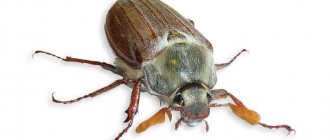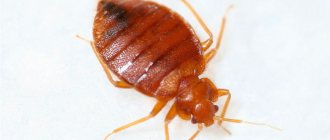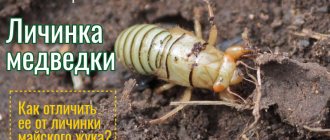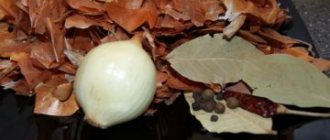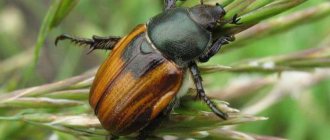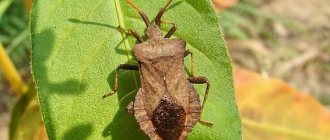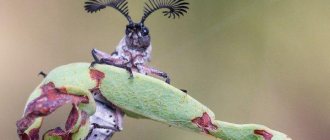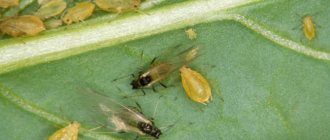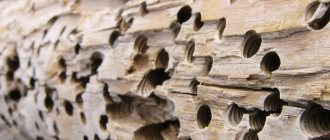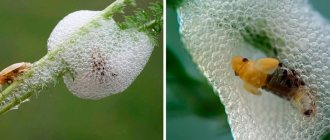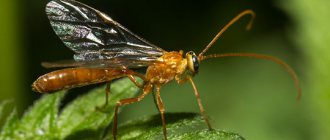Growing fruit and berry crops is painstaking work in itself. It is necessary to take care of planted plants taking into account unpredictable weather and climate. There are many diseases that need to be prevented and treated as soon as possible. Numerous pests cause considerable damage to the future harvest. Many of them are familiar to every gardener: snails, Colorado potato beetles, and so on. But not everyone knows how much damage the wingless red bug (Pyrrhocoris apterus) can cause. Therefore, it is worth considering what soldier bugs look like, what they eat, and how they reproduce. It is also important to determine why these pests have chosen the summer cottage and how best to deal with them.
What does a soldier bug look like (photo)
The soldier bug or wingless red bug, cossack bug, forest bug, red bug, garden bug is an insect of the red bug family.
Everyone has seen this insect. The soldier bug is one of the first to emerge into the light after hibernation, which is why it is called a harbinger of warmth. The size of the garden bug is small - from 7 to 12 mm. The body, like that of all bedbugs, is flattened and rounded, which makes it easy to penetrate hard-to-reach places. The soldier has no wings and cannot jump or fly. It is easily recognized by its bright red coloring with a black pattern.
Soldier bugs live in colonies; sometimes you can see a huge number of these insects on stumps or fallen trees, more than a hundred individuals in one place. They feed on the cell sap of plants and fruits with the help of a sharp proboscis, which cuts through the leaves, trunks and fruits of garden crops and weeds.
Morphology
Bed bugs with a body up to 7-12 mm come from the order Hemiptera. Bright coloring is a distinctive feature of insects. Their backs are decorated with a contrasting red and black pattern.
Gardeners find larvae, which bear little resemblance to adult individuals, under the bark of trees and among cultivated plants in their garden plots. The body of toy soldier larvae is red (some representatives have dark inclusions on the surface).
The bedbug's mouth is unusual. It is a piercing-sucking proboscis. With the help of such a red mouth, it easily penetrates plant tissue, the chitinous shells of dead insects and sucks out juices.
Pests settle in household plots in groups and entire colonies. They attack crop plants en masse. Also, insects go together for the winter, and in the summer they crawl out onto sunny lawns to warm up.
Features of the wingless red bug
From the beginning of the onset of warmth until autumn, on sunny areas of land near trees or bushes, you can see streams of red or orange insects with a black pattern. Moreover, some of them are funny coupled with each other like a steam locomotive with a carriage. This could be a brief description of the soldier bug. This beetle differs from other insects in its rounded, flat body and the absence of hind wings, so it does not fly.
This beetle is equipped with a thin, sharp proboscis. Therefore, it can feed not only on the pulp of plants, but also on the sap of trees. Its diet includes seeds, fallen fruits and small weeds. Among cultivated plants, the beetle prefers cabbage, beets and legumes, and does not disdain strawberries. The bug also feeds on other insects, sucking out the liquid inside them with its proboscis, but this is rare, although there are cases of cannibalism.
This insect reproduces quickly. The female leaves up to 30 eggs per clutch. They make nests in inconspicuous places: in leaves, tissues of plant shoots or tree trunks. The larvae, hatch after 1.5 weeks, differ little in appearance from adult insects, only smaller in size.
Pest recognition methods
The presence of a bedbug in an area can be determined by the presence of adults, clutches of eggs and larvae. The fight against an unpleasant neighborhood should begin with differentiating the pest from other species, many of which are useful to the gardener. Therefore, you need to study the soldier bug.
Top cover:
- orange with black pattern;
- sometimes yellow with the same ornament may be found;
- greenish yellow.
The description of the soldier bug is a bit like a beetle. But the beetle has an oblong, convex body, and the bug has an oval and flattened body. They can be distinguished by what the bugs eat and what the fireman beetle eats.
Knowing for sure what soldier bugs look like, that insects cannot fly at all, while the fireman beetle, although not very similar in appearance to a hemipteran pest, flies, albeit rather slowly, then there is not even a particular need to look at what the bug eats in order to do not confuse it with flying beetles, which bring undoubted benefits.
Bedbugs have quite characteristic differences to differentiate them:
- bright color with black spots;
- oval and flattened body;
- the presence on plants of clusters of eggs and larvae drinking juices from the leaves;
- characteristic marks on garden crops left after they have been saturated;
- death of individual plants that cannot tolerate the damage caused to them;
- traces of vital activity with a characteristic unpleasant odor.
Damaged cabbage leaf by the wingless red bug The damage that a cute and bright insect, completely harmless and ordinary in appearance, which everyone admired while observing in the green grass, can cause to a lovingly grown crop, causes only one thought to an experienced gardener or gardener: this is a soldier bug, like get rid?
Interesting facts about red bugs
- In winter, soldier bugs hibernate and stay there from December to March; they prefer to spend the winter in dry wooden structures or trees.
- Habitat: rotten stumps, fallen trees, wooden fences, vegetable garden.
- The type of development of the soldier bug is incomplete metamorphosis, i.e. transformation without a transitional stage - pupa.
- They leave behind an unpleasant odor. It stinks if you touch it, but it stinks more if you crush it.
- Bed bugs bite humans, the soldier bug does not bite, so you won’t even find photos of bite marks.
- The soldier bug is an insect with an appearance of the Müllerian mimicry type; its protective (warning) coloring is similar to that of a ladybug and some other insects.
- Birds do not eat the soldier bug, as it is poisonous and has a bright color.
- It does not bring any benefit to the garden or nature, only harm.
- The soldier bug lives from 6 months to a year.
- The soldier bug is often confused with the fireman beetle, although their differences are colossal.
Life cycle
The lifespan of the wingless bug is 12–14 months. When living in warm regions, two generations of insects appear, in cold regions - one.
The soldier larva does not have such a bright cover
By the end of August, the soldiers' metabolism slows down, i.e. they are preparing for hibernation - suspended animation. After going to sleep, insects survive due to the nutrients accumulated over the summer period and slow metabolism.
The awakening of bedbugs occurs in March - April, as soon as the sun begins to warm the earth and the first vegetation appears. Some young individuals and females cannot withstand the spring cold and die. In May, adult female bedbugs lay eggs. The process of insect formation takes place in several stages: egg – larva – bug. Newly formed females continue breeding in mid-late June.
What harm can the soldier bug cause?
The appearance of soldier bugs can be a big nuisance for a summer resident. Plants and trees that these insects feed on begin to shed their leaves, wither and, as a result, dry out. Fruits spoiled by the bug are unsuitable for food.
Since the soldier beetle reproduces very quickly, the appearance of a couple of individuals will already be a reason to raise the alarm. Within a matter of weeks, they can infect all the plants in the area. And this will lead to almost complete loss of the harvest.
The larvae cause particular harm. Hatching from the eggs, they begin to actively feed on the plant in which they have settled. Vineyard owners suffer more from the invasion of these insects, since the beetle eats both stems and fruits of these plants.
The red soldier bug is not dangerous to humans. Therefore, if an insect is found in the house, there is no reason to be afraid of it. Since it will emit a characteristic odor when crushed, it would be wiser to simply release it outside. Or use a broom and dustpan and flush the pests down the toilet.
Is your garden or balcony infested with firebugs?
Many gardeners may wonder if their plants are at risk and can they remove this infestation?
Red bug larvae prefer to live under the bark of dead trees, where they feed on worms. Sometimes they feed on the larvae of other beetle species, such as bark beetles. In rare cases, when food is insufficient, the larvae are prone to cannibalism.
Adult animals feed on nectar, pollen or honeydew. Development from larva to adult bedbug takes about two to three years. Pupation occurs in the cradle between the tree and the bark.
Red bugs contain cantharidin, a benzofuran compound. The natural product is created when animals eat other insects, and some species are used for mating females. Cantharidin is very irritating to human skin and mucous membranes, so be careful.
As mentioned, soldier bug larvae also feed on pests such as bark beetle larvae. Thus, they can be considered useful. Even adult beetles do not harm plants, since they feed mainly on dew. Fears that soldier bugs are pests are unfounded, even in mass cases. If you find animals on your plants in the garden, you have nothing to worry about.
Habitats
They take food in liquid form through their proboscis. To consume food, its proboscis bores a hole in the shell of fallen seeds or fruits, leaving a disintegrating secretion, and then absorbs the resulting nutrient-rich juice.
Soldier bugs prefer linden and mallow. In general, they are not considered hazardous to plant health. However, in the case of a particularly high concentration of beetles on one plant, it may happen that damage to flower buds or leaf buds occurs. But this is an extremely rare case.
Life cycle
Once temperatures rise in the spring, thousands of firebugs will crawl out of winter quarters in mid-March and bask in the first rays of sun on rocks, house walls or tree trunks. This, as stated above, increases their metabolism and prepares them for the upcoming breeding in April and May.
Copulation can take from several hours to several days. A female soldier bug mates with several males. Males try to prolong the duration of copulation as long as possible so that no competitor can then mate with the same female. This is why you can often observe how two fire beetles seem to hang endlessly over each other, or two beetles seem to be stuck together with their back parts.
A 30-hour sexual encounter begins, during which the female lays up to one hundred eggs in various locations and simply carries her partner on her back. To do this, the female looks for protected places, for example, under stones or a layer of leaves. After hatching in May, the nymphs go through six different juvenile stages with different colors until they finally reach the emergence of the soldier beetle. Only one generation of fire beetles is born each year.
Signs of the appearance of wingless soldier bugs in the garden
Knowing what soldier bugs look like and what signs can be used to determine their presence, a summer resident can take measures to protect his crop. Here are the signs you shouldn't ignore:
- the plants' buds and flowers began to fall off;
- yellow spots appear and leaves die on the cabbage;
- plants from the umbrella family dry out quickly;
- the tops on the beets began to curl and dry out.
It is important to pay attention to these factors. In addition, you can see one or several individuals basking in the sun. Since this is their usual habit, it is worth inspecting all areas and tree trunks for these insects or their larvae. And remember that even a small number of bedbugs will cause great harm to the farm. Therefore, the sooner measures are taken, the better.
Habitat
Gardens and vegetable gardens are the abode of soldier bugs. To build nests, insects climb into logs, tree trunks, and fences made of boards and pickets that are rotten from old age. At times, soldiers literally swarm on wood surfaces.
However, these corners are intended for pests to rest. Red bugs hunt on young vegetation planted in personal plots. Soldiers cause enormous damage to gardeners, reducing yields. Beds with cabbage, carrots, beets, fruit trees and shrubs are favorite places for bedbugs to hunt.
How to get rid of soldier bugs in the garden?
If a gardener notices that soldier bugs have appeared on his property, how can he get rid of them correctly and without harm to his own health? Let us consider several ways in which such a struggle can be waged.
By knowing what the beetle eats, you can minimize the plants it loves. So, simple removal of weeds . If this is not a garden bed, but a lawn, you need to mow the grass at least once a week. Moreover, it is better not to pile up the collected shoots with roots, but to burn them immediately. This is especially true for wormwood and quinoa, which can often contain bedbugs.
When planning a summer cottage, it is better to plant legumes and alfalfa at a distance from other plants. Bedbugs prefer these crops for wintering. And in the spring, insects can quickly crawl onto something more edible.
A simple and harmless way for humans is to plant black cohosh in the garden. The specific smell of this plant can repel insects and minimize the harm they cause.
If you are just a beginner gardener and there are weeds growing next to your beds, it is worth making a strip of land around the perimeter of the site, on which there will be no plants. Since bedbugs are not flying insects, land devoid of vegetation will be a serious obstacle for them.
In addition to plants, this beetle loves the trunks of living trees, as well as dry stumps, boards or logs. If there are similar items on the site, and no one is going to use them, it makes sense to remove them from the garden to another place or destroy them.
chemicals are widely used to combat insects. One such remedy is Bankol . Its advantage is that both adults and larvae die from it. The paralytic effect it provides produces an effect within 3 days. It is worth remembering that any chemical preparations are not safe for humans. Therefore, such procedures are carried out in the spring, until flowers and fruits form on the plants.
One of the simple and at the same time labor-intensive processes is manual collection of beetles . It can be used when several individuals are detected and on a small area of land. But there are some disadvantages: even one or two missed insects can produce offspring in a short time. Especially if the collected bugs have already laid eggs.
Prevention
Experienced gardeners follow preventive measures to prevent red bugs from entering the estate.
The soldiers' favorite food is alfalfa and beans. Therefore, cabbage, carrots, dill and other garden crops are planted at a decent distance from such vegetation.
The use of natural remedies to combat soldiers is always justified. Biological preparations do not cause damage to plants and expel bed bugs, serious pests, from garden plots.
Folk remedies against soldier bugs
Among herbal preparations against bedbugs, the following infusion is widely used. It is based on laundry soap, onion peels, mustard powder and wood ash. Spraying with this infusion destroys pests without side effects for plants and humans. Folk recipes for soldier bugs also involve the use of these ingredients separately.
- Soap solution: laundry soap or “green soap” is diluted and the plantings are treated with it.
- Onion peels: an infusion or decoction of onion peels is prepared, infused for about 5 days, after which the plantings are treated once a week for a month.
- Mustard: a mustard solution is prepared, it is not necessary to settle it, the processing is carried out in the same way as an infusion of onion peels.
Fighting methods
So, after you have found one or more signs of the appearance of this insect in your garden, you need to make sure that it is a soldier bug by finding one or more representatives in your area. This is very easy to do thanks to their color. After this, it is worth starting to destroy the pest.
Traditional methods
There is no point in immediately starting heavy artillery using pesticides. It’s better to start with softer traditional methods that are less likely to damage your agrocenosis.
This solution should be sprayed on areas with infected plants 1-2 times a week.
Another effective way to combat this pest can be to plant some types of plants on the site, for example black cohosh (commonly called black cohosh).
Another effective way to exterminate bedbugs is to install a catching belt. A sticky strip wraps around the base of the tree trunk, where the soldier bug is most often found.
Natural enemies
The soldier bug has a gland on its back that produces an unpleasant-smelling secretion, a warning color and a bitter taste; therefore, it is not the most attractive delicacy, so a bird can only eat a bug very rarely.
This representative of hemipterans is quite large, so it also has no enemies among insects, except that ants may not disdain a dead bug. However, interspecific cannibalism occurs in the order Hemiptera, especially during the wintering period. Therefore, we can say that the natural enemies of soldier bugs are themselves and humans.
To combat bugs with soldier bugs, certain measures are required, so it is very important to know for sure that your area is besieged by these pests. There are signs of damage characteristic of these harmful insects:
There are signs of damage characteristic of these harmful insects:
- buds and flowers fall;
- cabbage leaves become covered with yellow spots and partially die;
- umbrella plants dry out very quickly;
- the beet tops curl and dry;
How to deal with uninvited guests and prevent their further possible appearance?
- garden crops should be interspersed with black cohosh. This fragrant plant can repel bedbugs. They will leave your suburban area forever;
- alfalfa and legumes should be planted away from fruit and berry crops, since toy soldiers overwinter on these plants and will appear on your site in early spring;
- Bankol is an absolutely harmless product for people and animals that has a detrimental effect on bedbugs. 7-10 mg. the powder is diluted in 10 liters of water and sprayed on all vegetation;
- it is necessary to monitor the cleanliness of the area, weed weeds in a timely manner, and burn the grass;
- it is advisable to have a strip of clean land between the weeds and the garden, this will also help protect your land from the influx of bedbugs;
- treat the area with insecticidal agents against the Colorado potato beetle. It must be remembered that insecticides kill not only pests, but also beneficial insects. Chemicals also harm the crop and its environmental friendliness;
- treat the area with a decoction of onion peels;
Soldier bugs are not the most serious pests that can become an irreparable disaster for summer cottages. It’s quite easy to deal with them, you just need to do it in time, without waiting for their mass distribution.
If you find an error, please highlight a piece of text and press Ctrl Enter.
Last resort
Well, one last thing. If everything has been tried, and annoying enemies appear here and there, you can resort to a radical solution and use special chemicals - insecticides. One of the most common is Karbofos, which can be purchased at a store for summer residents. Follow the instructions, pour the solution over the infected areas and corners in the room and you can relax - insects will not be safe.
There is another option - Bankol. It instantly destroys soldier bugs, and other insects too, if necessary. Sinuzan, Sichlor and others are no less effective. But before you buy them, make sure that you are not allergic to these drugs. And, of course, keep them away from children. Have a good fight!
Doesn't bite, doesn't fly
Although in fact the soldier is not a beetle, but a bug. And it has many names: there are scientific ones - the common redbug, or the wingless redbug, and there are local ones - Cossack or Moskalik (this is what this bug is called in Ukraine for its bright red color, reminiscent of the caftan of the Moscow archers). So why did this confusion occur and what allowed scientists to attribute the soldier soldier specifically to bedbugs, and not to beetles?
Firstly, bedbugs do not have the pupal development stage that beetles have.
Secondly, these insects have a different structure of the oral apparatus - our soldier, like his other bug relatives, has a piercing-sucking one, but in beetles it is a gnawing one. Thirdly, they also differ in the structure of their wings: beetles have rigid front wing elytra and do not participate in flight - they fly on their hind wings. But bedbugs have a chitinous covering at the ends of the front elytra with membranes, but the back ones (like, for example, the toy soldier) may not have. Therefore, the common red bug does not fly.
